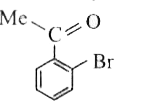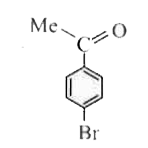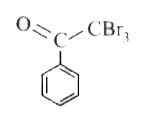Bromination of (E)-2-butenedioic acid gives
(2R, 3S)-2, 3-dibromosuccinic acid
(2R, 3R)-2, 3-dibromosuccinic acid
a mixture of (2R, 3R) and (2S, 3S)-2,3-dibromosuccinic acid
(2S, 3S)-2,3-dibromosuccinic acid
The correct Answer is:A
To solve the problem of what product is formed from the bromination of (E)-2-butenedioic acid, we can follow these steps:
1. Identify the Structure of (E)-2-butenedioic acid:
- The structure of (E)-2-butenedioic acid (also known as fumaric acid) can be represented as:
HOOC-CH=CH-COOH
- In this structure, the two carboxylic acid groups (COOH) are on opposite sides of the double bond, which is characteristic of the E configuration.
2. Understand the Bromination Reaction:
- Bromination involves the addition of bromine (Br2) across the double bond. The reaction can be represented as:
C=C+Br2→Br-CH-CH-Br
- This reaction proceeds through a cyclic bromonium ion intermediate.
3. Mechanism of Bromination:
- The Br2 molecule dissociates into Br+ and Br−. The Br+ attacks one of the carbons of the double bond, forming a bromonium ion.
- The Br− then attacks the more substituted carbon from the opposite side (backside attack), leading to anti-addition.
4. Draw the Product:
- After the bromination, the product will have bromine atoms added to the two carbons of the double bond. The resulting structure will be:
HOOC-CH(Br)-C(Br)-COOH
- This product is known as 2,3-dibromosuccinic acid.
5. Determine the Configuration:
- The product will have two stereocenters at the carbons where bromine is added. The configurations can be determined by assigning priorities based on the Cahn-Ingold-Prelog rules.
- The resulting product will have one stereocenter with R configuration and the other with S configuration, leading to the final product being 2R, 3S-2,3-dibromosuccinic acid.
Final Answer:
The product of the bromination of (E)-2-butenedioic acid is 2R, 3S-2,3-dibromosuccinic acid.
---
- The structure of (E)-2-butenedioic acid (also known as fumaric acid) can be represented as:
HOOC-CH=CH-COOH
- In this structure, the two carboxylic acid groups (COOH) are on opposite sides of the double bond, which is characteristic of the E configuration.
- Bromination involves the addition of bromine (Br2) across the double bond. The reaction can be represented as:
C=C+Br2→Br-CH-CH-Br
- This reaction proceeds through a cyclic bromonium ion intermediate.
- The Br2 molecule dissociates into Br+ and Br−. The Br+ attacks one of the carbons of the double bond, forming a bromonium ion.
- The Br− then attacks the more substituted carbon from the opposite side (backside attack), leading to anti-addition.
- After the bromination, the product will have bromine atoms added to the two carbons of the double bond. The resulting structure will be:
HOOC-CH(Br)-C(Br)-COOH
- This product is known as 2,3-dibromosuccinic acid.
- The product will have two stereocenters at the carbons where bromine is added. The configurations can be determined by assigning priorities based on the Cahn-Ingold-Prelog rules.
- The resulting product will have one stereocenter with R configuration and the other with S configuration, leading to the final product being 2R, 3S-2,3-dibromosuccinic acid.
The product of the bromination of (E)-2-butenedioic acid is 2R, 3S-2,3-dibromosuccinic acid.
Topper's Solved these Questions
- BOOK - MS CHOUHANCHAPTER - HYDROCARBONS (ALKENES)EXERCISE - Level 1 (Q.1 To Q.30)1videos
HYDROCARBONS (ALKENES)
- BOOK - MS CHOUHANCHAPTER - HYDROCARBONS (ALKENES)EXERCISE - Level 1 (Q.61 To Q.90)2videos
HYDROCARBONS (ALKENES)
- BOOK - MS CHOUHANCHAPTER - HYDROCARBONS (ALKANES)EXERCISE - Level 1 (Q.31 To Q.50)1videos
HYDROCARBONS (ALKANES)
- BOOK - MS CHOUHANCHAPTER - HYDROCARBONS (ALKYNES)EXERCISE - Level 1 (Q.1 To Q.30)2videos
HYDROCARBONS (ALKYNES)
Similar Questions
Knowledge Check
- Question 1 - Select One
Bromination of n-butane gives
A1-bromobutane as the major productB2-bromobutane as the major productCboth 1-bromo and 2-bromobutane with equal percentageDboth 1-bromo and 2-bromo products whose percentage depends on temperature - Question 2 - Select One
On bromination, propionic acid gives two isomeric 2-bromopropionic acids. This pair is an example of
Aoptical isomersBcis-trans isomersCchain isomersDposition isomers - Question 3 - Select One
Bromination of PhCOMe in acetic acid medium produces mainly
A B
B C
C D
D
On bromination, propionic acid gives two isomeric 2-bromopropionic acids. This pair is an example of
View SolutionBromination of aniline gives 2,4,6-tribromoaniline, whereas the nitration of aniline with mixed acids gives m-nitroaniline. In the case of nitration, the m-derivative is formed because
View SolutionAssertion (A) Like bromination of benzene, bromination of phenol is also carried out in the presence of Lewis acid.
Reason (R) Lewis acid polarises the bromine molecule.View SolutionThe bromination of acetylene gives __________ as the final product .
View SolutionThe main product of bromination of acetanilide in glacial acetic acid is
View Solution

